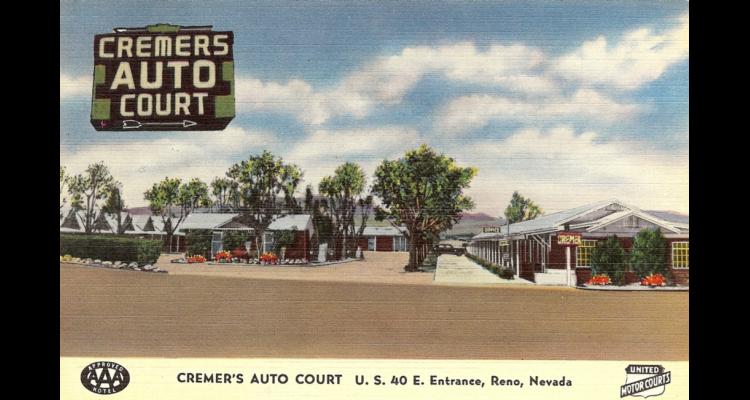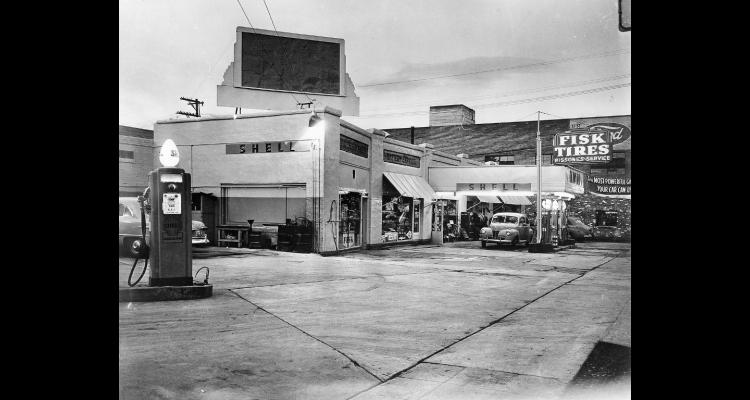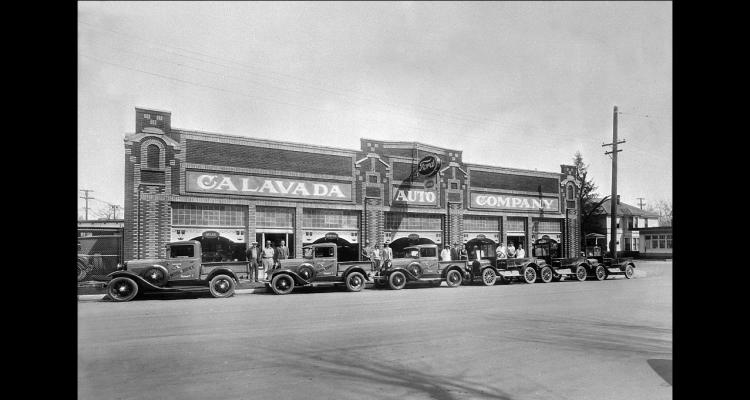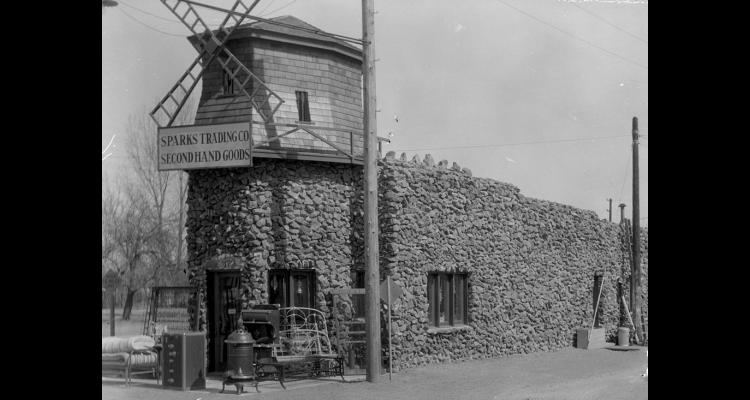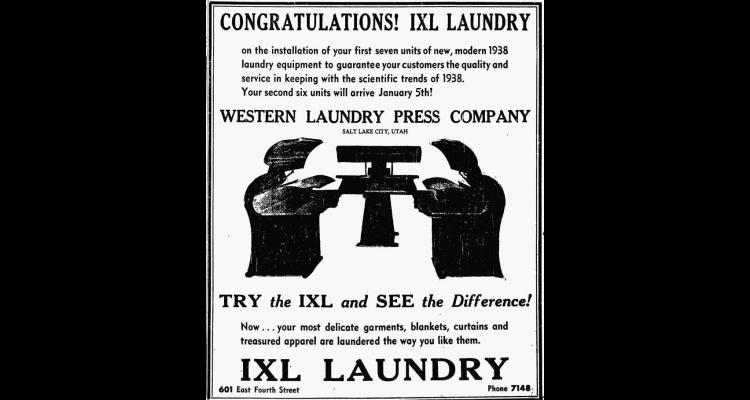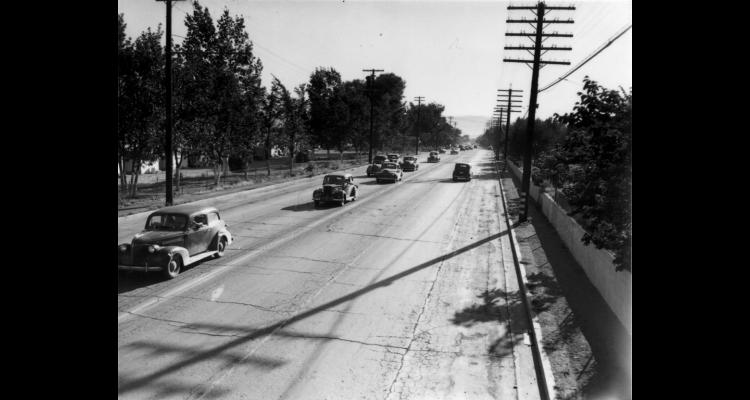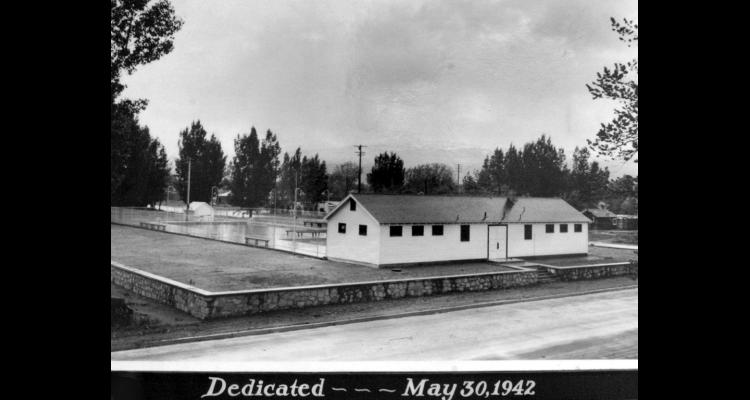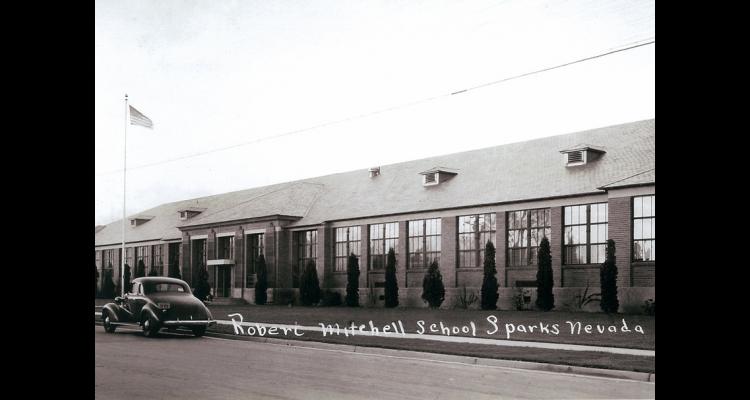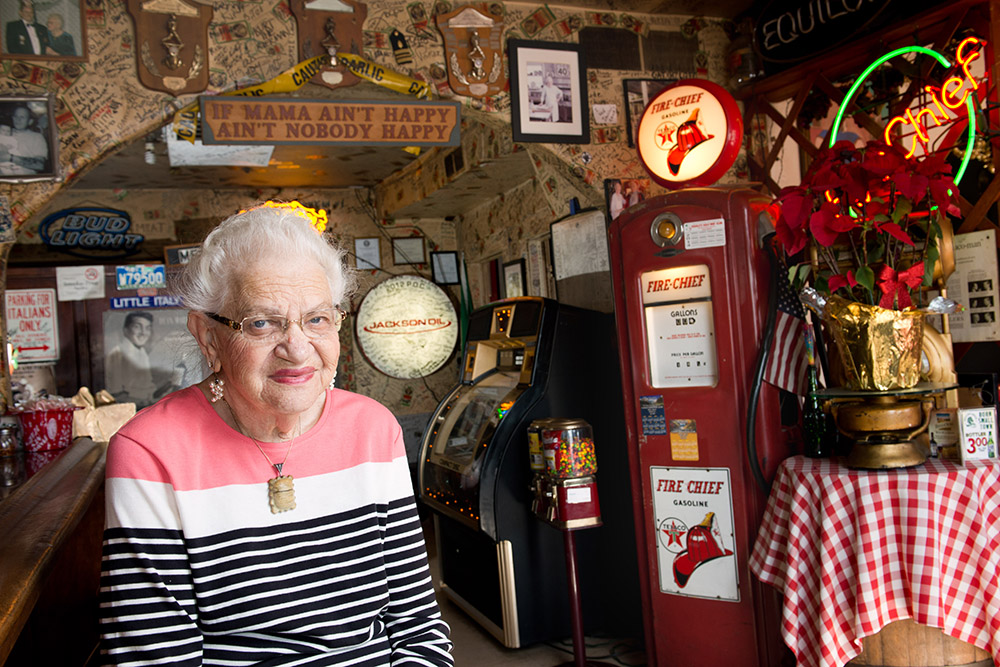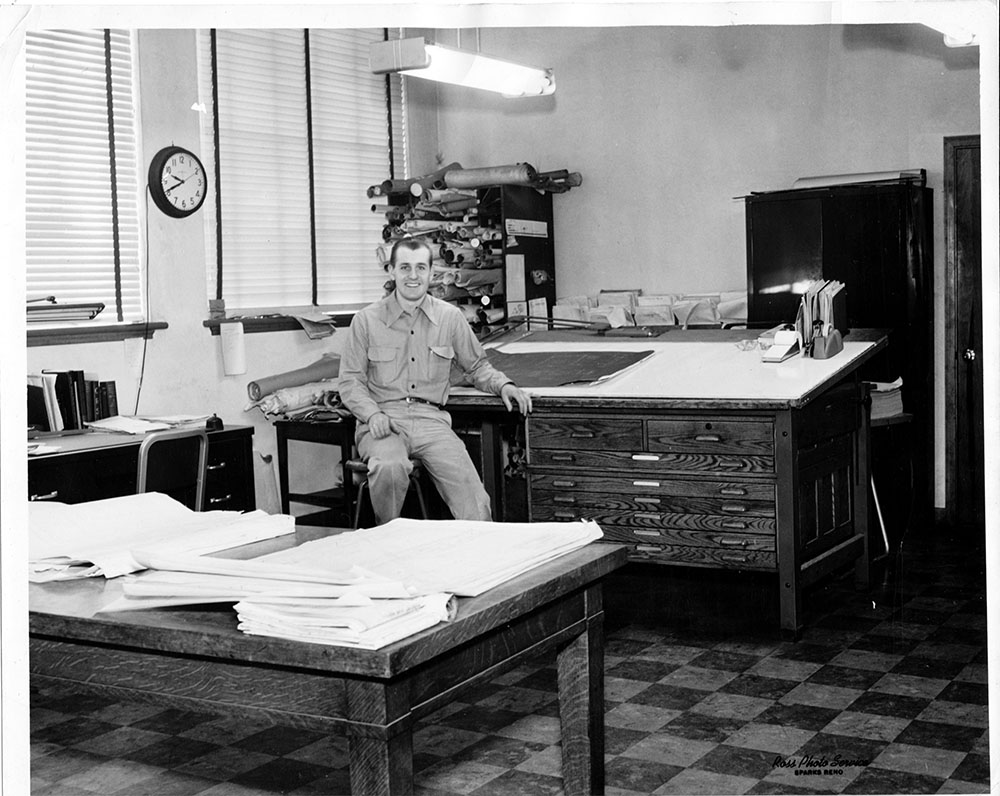New business blocks were constructed on East 4th Street, while Prater Way gained a new Robert H. Mitchell Elementary School building and a swimming pool at Deer Park.
From the Great Depression and the New Deal to the steady drumbeat of approaching war, the 1930s and early 1940s were eventful years in the United States. This was especially true in Nevada, where the state legislature took two momentous steps in 1931, legalizing wide-open gambling and the six-week divorce. Both actions catapulted the state into the national spotlight, spurring the improvement of tourist accommodations throughout the area and boosting the local economy.
A Landscape of Labor
In the 1930s, the large industrial spaces and yards of East 4th Street began to fill in with new commercial buildings, tying the neighborhood more closely to the rest of the city. Within the space of a few years, the northern side of the block between and Valley and Elko Streets, formerly a lumber storage yard, became a row of businesses including Nevada Welding, the Triangle Produce Company, Union Iron Works, and Allied Equipment.
In the same decade, many existing companies built larger brick warehouses and workplaces in the vicinity, including, just to the north, the Zellerbach Paper Company, and one block east, the IXL Laundry. German immigrant Martin Schwamb founded Martin Iron Works in 1939 at its original location on Morrill Avenue.
Together with the continued operation of Eveleth Lumber, the Flanigan Warehouse, Nevada Packing, and other industries, the area buzzed with local manufacturing. Having survived Prohibition, the Reno Brewing Company constructed an impressive new bottling plant next to its original building in 1940.
Tourism along U.S. 40
When the Bureau of Public Roads first adopted its new numbering system, U.S. 40 ran in a clear line from 4th Street in Reno eastward along the rural County Road to Prater Way. At 15th Street in Sparks, the highway turned south to meet up with B Street (now Victorian Avenue) and then proceeded east through the main commercial district and out of town.
As a result, the entire distance from West 4th Street in Reno through 15th Street in Sparks was dotted with auto camps and auto courts, the precursors to modern motels. The Silver State Lodge and others operated west of Reno, with the largest number located in the open expanse between Reno and Sparks. The Coney Island area was a busy hub, with the Coney Island Auto Camp, the Star Auto Court, and Julius Redelius’ place, now known as The Grove Auto Camp. Closer into Reno, the Central Auto Tourist Camp and All States Tourist Camp operated near Alameda (later Wells) Avenue.
Auto camps also abounded along Prater Way, the name used interchangeably with County Road within Sparks city limits (Prater Way officially became the name of the entire stretch in 1939). In the early 1930s, Mabel Smith operated a tourist camp at 15th Street and Prater that would eventually become the Park Motel, and Deer Park retained a municipal campground until 1933, the same year local businessman George K. Cremer and his wife, Bess, founded Cremer’s Auto Court on Sparks’ western border. At least five other tourist camps operated along Prater Way by the early 1930s.
The busy street might have remained a tourist corridor for years to come, but its trajectory changed forever in 1934 with the decision to straighten the route of U.S. 40 through Sparks. The construction of an extension linking B Street directly to the County Road near Coney Island created the junction now known as the “Y” (where Victorian meets Prater) and took Prater Way off the route of the highway for good. The plan met with protests from area business operators, including the owners of Gepford’s Used Furniture Store, Younghans’ service station, and auto camp operator Mabel Smith, but from that point forward, Prater Way would be oriented primarily toward residents, not the tourist trade.
New Deal Projects along the Corridor
A major incentive for changing the highway’s route in 1934 was the availability of federal funds to help offset the costs. Many New Deal programs, introduced by the federal government to provide the “three Rs” (Relief, Recovery, and Reform) during the Great Depression consisted of road and highway projects, which improved the country’s infrastructure while putting its citizens to work.
In 1934, just over two miles of the Sparks highway, including the new so-called “B Street extension,” were paved in asphalt, giving motorists a four-lane highway, forty feet wide, with an eight-foot parking area on each side. Another project, begun in 1936, constructed a tunnel under the railroad line south of 4th Street, linking Wells Avenue on the south to Alameda Avenue on the north (the entire length was eventually named Wells Avenue). That project also demolished a cattle bridge across the Truckee River that had allowed livestock to be driven to the Nevada Packing Company on 4th Street from the ranches south of the river without going through the heart of downtown Reno.
On the Sparks side, Public Works Administration (PWA) funds enabled the construction of a new building for Robert H. Mitchell Elementary School, until then still housed in its original 1906 structure. The new building opened to much fanfare in 1939. Equally exciting for the community were improvements at Deer Park, including fencing and a brand-new municipal swimming pool, which opened in 1942.
Family Businesses and Community Spaces
Deer Park was not the only recreational space on the corridor in this era. In 1930, Reno Garage owner Jack Threlkel opened a semi-professional baseball park halfway between Reno and Sparks. Although Reno already had a baseball field at Moana Springs, Threlkel’s was said to be the only grass-covered field in the state. Most certainly it was the only one with a chicken and turkey pen in right field. With a wooden stadium and night lighting beginning in 1940, the ballpark drew hundreds of spectators per game and brought in teams from the entire region.
This was a close-knit community, where families could make a living operating small, independent markets, bars, and restaurants. In 1931, John and Elvira Casale opened a fruit stand and added a seating area to it ten years later, eventually naming the place Casale’s Halfway Club for its location between the two towns. By 1944, the Restwell Auto Court was open next door. Just down the road, Ralph Galletti constructed a brick building for his Coney Island Tamale Factory in 1936, adding a lunch room and kitchen. Adjacent to it, LaVerne Sorensen opened the Copenhagen Bar and liquor store.
In this pre-chain era, small markets appeared every few blocks, offering groceries, meats, and supplies to the neighborhoods on either side of Prater Way and north of East 4th Street. Albert R. Cave opened Cave Grocery at the corner of 15th and Prater Way in a rustic rock-covered building formerly housing the Sparks Trading Company. Grant Anderson operated two markets along the corridor: Anderson’s Market at 4th and Alameda, and Pyramid Market at Coney Island and Prater. In Reno, the Hotel Richelieu housed the Lincoln Market on its ground floor until 1936, when it transformed into the popular Lincoln Bar. Across the street, the former Royal Hotel, now called the Marion Hotel, housed the Victory Market, a fine wartime moniker.
A new brick hotel opened up on East 4th Street in 1931, financed by Frank Savage of the local plumbing firm, Savage & Son. At first known as the Bonney Hotel (later renamed the Morris Hotel), the three-story building featured 40 rooms and, in 1941, leased the ground floor to the glamorous Dorothy Romaine Shoppe. The combination of hotel and boutique would no doubt prove enticing to the divorce-seekers thronging to the area to rid themselves of their marital ties.
The War Years
World War II had a clear impact on the corridor, as it did everywhere. Threlkel’s ball park temporarily closed, and businesses throughout the area dedicated themselves to selling war bonds and stamps. By 1944, Dick Wagner of the Wagner Tank and Manufacturing Company had secured enough wartime contracts to purchase the buildings and foundry of the Provo foundry and Machinery Company in Utah and have them dismantled and reassembled across the street from his existing operations in the combined Union Iron Works and Nevada Welding buildings.
The Farmers Exchange, a local co-operative, served as an agent for the War Food Administration, distributing eggs, butter, and other supplies to the armed forces. In the meantime, the Eveleth Lumber Company encouraged local producers to make improvements to their farms and ranches in order to enhance their output for the war effort. Members of Civilian Defense groups watched Red Cross first aid motion pictures in the Robert H. Mitchell Elementary auditorium. After the war, the Tovrea Farm Equipment Co. on East 4th Street offered customers a chance to purchase the first “peace-time Jeeps” in town. After years of hardship and anxiety, a new age of prosperity beckoned.
